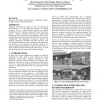Free Online Productivity Tools
i2Speak
i2Symbol
i2OCR
iTex2Img
iWeb2Print
iWeb2Shot
i2Type
iPdf2Split
iPdf2Merge
i2Bopomofo
i2Arabic
i2Style
i2Image
i2PDF
iLatex2Rtf
Sci2ools
SAC
2002
ACM
2002
ACM
Emergent situations in interactive storytelling
Interactive storytelling can either be based on explicit plot representations or on the autonomous behaviour of artificial characters. In such a character-based approach, the dynamic interaction between characters generates the actual plot from a generic storyline. Characters' behaviours are implemented through real-time search-based planning techniques. However, the top-down planning systems that control artificial actors need to be complemented with appropriate mechanisms dealing with emerging ("bottom-up") situations of narrative relevance. After discussing the determinants of plot variability and the mechanisms that account for the emergence of narrative situations, we introduce additional mechanisms for coping with these situations. These comprise situated reasoning and action repair: we most specifically illustrate the latter through a detailed example.
Applied Computing | Explicit Plot Representations | Real-time Search-based Planning | SAC 2002 | Top-down Planning Systems |
| Added | 23 Dec 2010 |
| Updated | 23 Dec 2010 |
| Type | Journal |
| Year | 2002 |
| Where | SAC |
| Authors | Marc Cavazza, Fred Charles, Steven J. Mead |
Comments (0)

